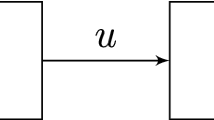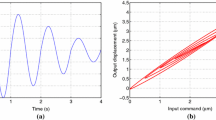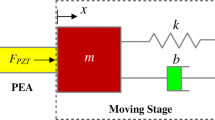Abstract
Piezoelectric actuators are widely used in micro manipulation applications. However hysteresis nonlinearity limits accuracy of these actuators. This paper presents a novel approach for utilizing a piezoelectric nano-stage as slave manipulator of a teleoperation system. The Prandtl-Ishlinskii (PI) model is used to model actuator hysteresis in feedforward scheme to cancel out this nonlinearity. To deal with the influence of parametric uncertainties, unmodeled dynamics, and PI identification error a perturbation term is added to the slave model and apply a sliding mode based impedance control with perturbation estimation. The stability of the entire system is guaranteed by Llewellyn’s absolute stability criterion. Performance of the proposed controllers is verified through experiments.
Similar content being viewed by others
References
Sheridan, T. B., “Telerobotics, Automation, and Human Supervisory Control,” MIT Press, 1992.
Pillarisetti, A., Anjum, W., Friedman, G. and Brooks, A. D., “Force Feedback Interface for Cell Injection,” Proceedings of the First Joint Eurohaptics Conference and Symposium on Haptic Interfaces for Virtual Environment and Teleoperator Systems, pp. 391–400, 2005.
Gersem, D. G., “Kinaesthetic feedback and enhanced sensitivity in robotic endoscopic telesurgery,” Ph.D. Dissertation, Department of Mechanical Engineering, Katholieke Universiteit Leuven, 2005.
Preusche, C., Ortmaier, T. and Hirzinger, G., “Teleoperation concepts in minimal invasive surgery,” Control Engineering Practice, Vol. 10,Issue 11, pp. 1245–1250, 2002.
Sitti, M. and Hashimoto, H., “Macro to nano telemanipulation towards nanoelectromechanical systems,” Journal of Robotics and Mechatronics, Vol. 12, No. 3, pp. 209–217, 2000.
Sitti, M. and Hashimoto, H., “Tele-Nanorobotics Using Atomic Force Microscope as a Robot and Sensor,” Advanced Robotics Journal, Vol. 13, No. 4, pp. 417–436, 1999.
Onal, C. D., Pawashe, C. and Sitti, M., “A Scaled Bilateral Control System for Experimental 1-D Teleoperated Nanomanipulation Applications,” Proceeding of the IEEE/RSJ International Conference on Intelligent Robots and Systems, pp. 483–488, 2007.
Ge, P. and Jouaneh, M., “Modeling hysteresis in piezoceramic actuators,” Precision Engineering, Vol. 17, No. 3, pp. 211–221, 1995.
Bashash, S. and Jalili, N., “Robust Multiple Frequency Trajectory Tracking Control of Piezoelectrically Driven Micro/Nanopositioning Systems,” IEEE Trans. Control Syst. Technology, Vol. 15, No. 5, pp. 867–878, 2007.
Newcomb, C. and Filnn, I., “Improving linearity of piezoelectric ceramic actuators,” Electronic Letters, Vol. 18, No. 11, pp. 442–444, 1982.
Furutani, K., Urushibata, M. and Mohri, N., “Displacement control of piezoelectric element by feedback of induced charge,” Nanotechnology, Vol. 9, No. 2, pp. 93–98, 1998.
Leang, K. K. and Devasia, S., “Design of hysteresis-compensating iterative learning control for piezo-positioners: Application to atomic force microscopes,” Mechatronics, Vol. 16, No. 3, pp. 141–158, 2006.
Hu, H., Georgiou, H. M. S. and Ben-Mrad, R., “Enhancement of Tracking Ability in Piezoceramic Actuators,” Mechatronics, Vol. 10, No. 2, pp. 230–239, 2005.
Kim, I., Kim, Y.-S. and Park, E.-C., “Sliding Mode Control of the Inchworm Displacement with Hysteresis Compensation,” Int. J. Prec. Eng. Manuf., Vol. 10, No. 3, pp. 43–49, 2009.
Kuhnen, K. and Janocha, H., “Complex hysteresis modeling of a broad class of hysteretic nonlinearities,” Proc. of the 8th Int. Conf. on New Achraiors, pp. 688–691, 2002.
Habibollahi, H. H., Rezaei, S. M., Ghidary, S. S., Zareinejad, M. and Seifabadi, R., “Hysteresis Compensation of Piezoelectric Actuator under dynamic load condition,” Proceeding of the IEEE/RSJ International Conference on Intelligent Robots and Systems, pp. 1166–1171, 2007.
Lining, S., Changhai, R., Weibin, R., Liguo, C. and Minxiu, K., “Tracking control of piezoelectric actuator based on a new mathematical model,” J. Micromechanics and Microengineering, Vol. 14, No. 11, pp. 1439–1444, 2004.
Ang, W. T., Garmon, F. A., Khosla, P. K. and Riviere, C. N., “Feedforward Controller with Inverse Rate-Dependent Model for Piezoelectric Actuators in Trajectory-Tracking Applications,” Mechatronics, Vol. 12, No. 2, pp. 134–142, 2007.
Buttolo, P., Braathern, P. and Hannaford, B., “Sliding Control of Force Reflecting Teleoperation: Preliminary Studies,” Presence, Vol. 3, No. 2, pp. 158–172, 1994.
Park, J. H. and Cho, H. C., “Sliding-mode controller for bilateral teleoperation with varying time delay,” Proceedings of the IEEE/ASME International Conference on Advanced Intelligent Mechatronics, pp. 311–316, 1999.
Cho, H. C., Park, J. H., Kim, K. and Park, J.-O., “Sliding modebased impedance controller for bilateral teleopertation under varying time-delay,” Proceedings of the IEEE International Conference on Robotics and Automation, Vol. 1, pp. 1025–1030, 2001.
Niemeyer, G. and Slotine, J. J. E., “Towards Force-Reflecting Teleoperation over the Internet,” Proc. Of IEEE Int. Conf. on Robotic and Automation, Vol. 3, pp. 1909–1915, 1998.
Haykin, S. S., “Active network theory,” Addison-Wesley, 1970.
Elmali, H. and Olgac, N., “Sliding mode control with perturbation estimation (SMCPE): A new approach,” Int. J. Control, Vol. 56, No. 4, pp. 923–941, 1992.
Elmali, H. and Olgac, N., “Implementation of sliding mode control with perturbation estimation (SMCPE),” IEEE Trans. Control Syst. Technol., Vol. 4, No. 1, pp. 79–85, 1996.
Hokayem, P. F. and Spong, M. W., “Bilateral Teleoperation: An Historical Survey,” Automatica, Vol. 49, No. 12, pp. 2035–2057, 2006.
Hashtrudi-Zaad, K. and Salcudean, S. E., “Analysis of Control Architectures for Teleoperation Systems with Impedance/Admittance Master and Slave Manipulators,” International Journal of Robotics Research, Vol. 20, No. 6, pp. 419–445, 2001.
Cahyadi, A. I. and Yamamoto, Y., “Teleoperated 3-DOF micromanipulation system with force feedback capability: design and experiments,” Industrial Robot, Vol. 35, No. 4, pp. 337–346, 2008.
Author information
Authors and Affiliations
Corresponding author
Rights and permissions
About this article
Cite this article
Zareinejad, M., Ghidary, S.S., Rezaei, S.M. et al. Precision control of a piezo-actuated micro telemanipulation system. Int. J. Precis. Eng. Manuf. 11, 55–65 (2010). https://doi.org/10.1007/s12541-010-0007-2
Received:
Accepted:
Published:
Issue Date:
DOI: https://doi.org/10.1007/s12541-010-0007-2




